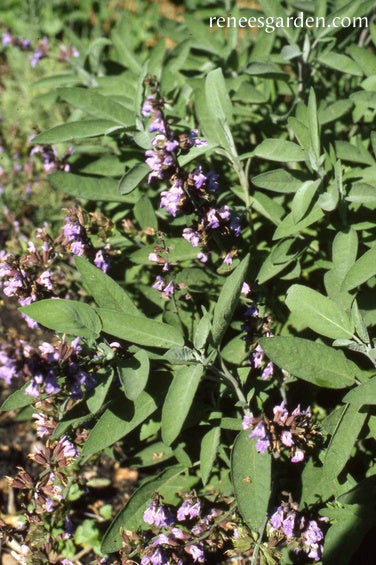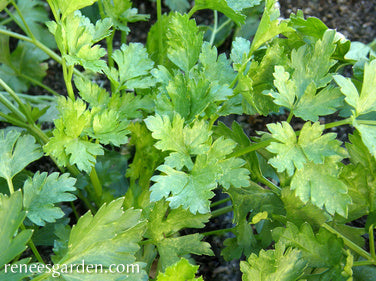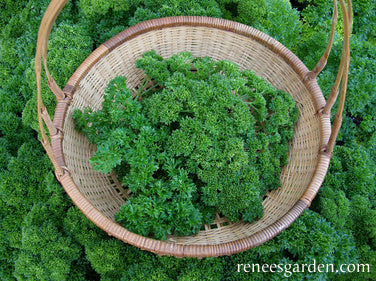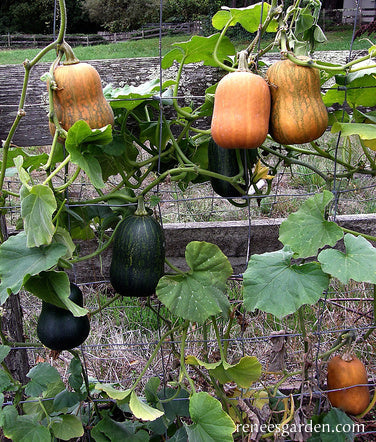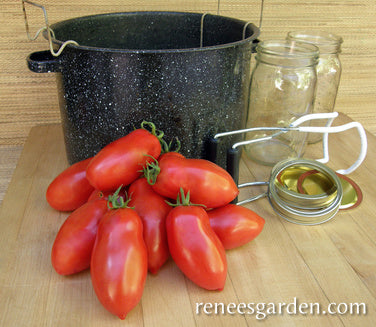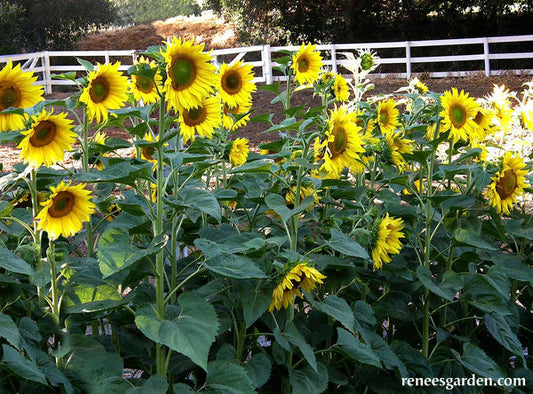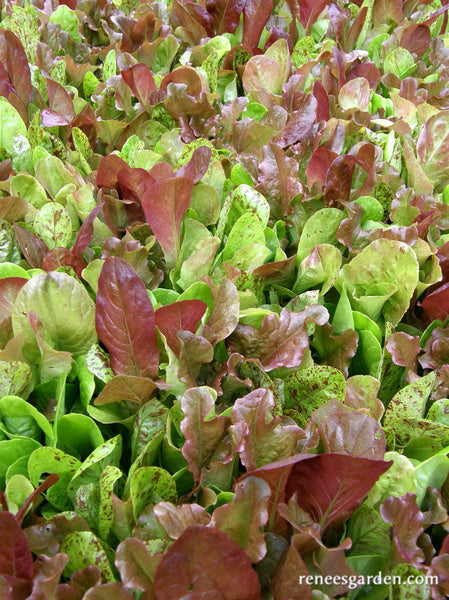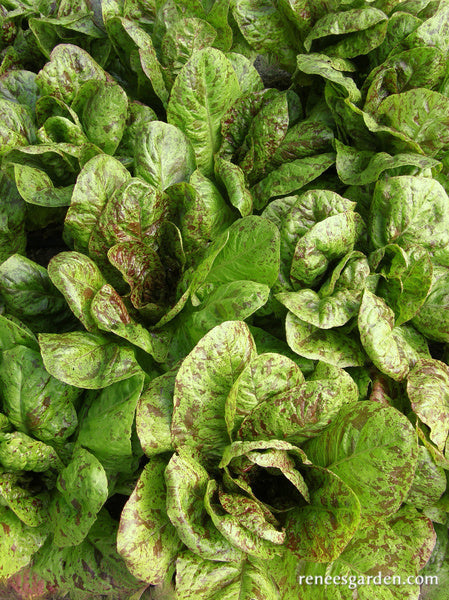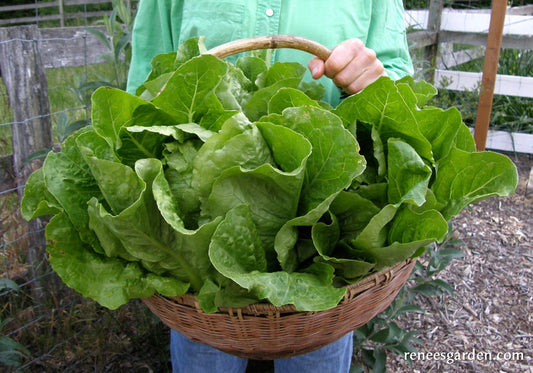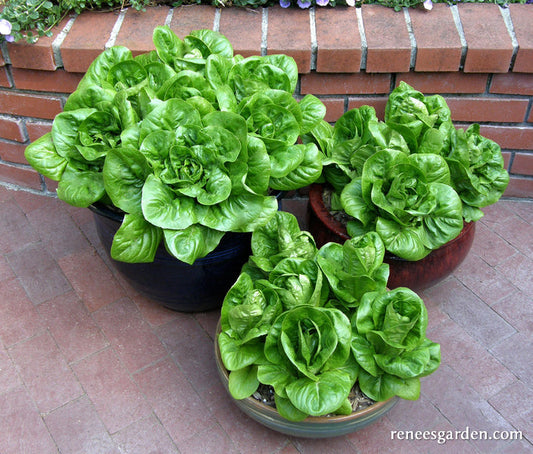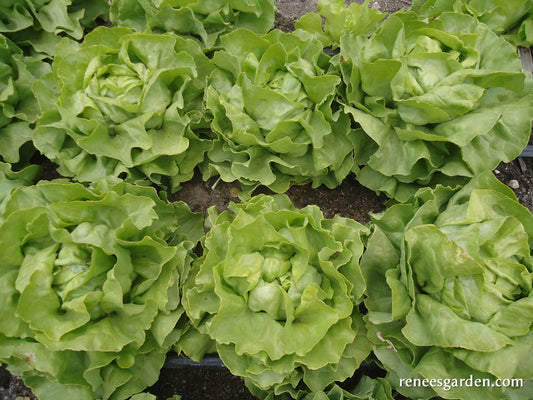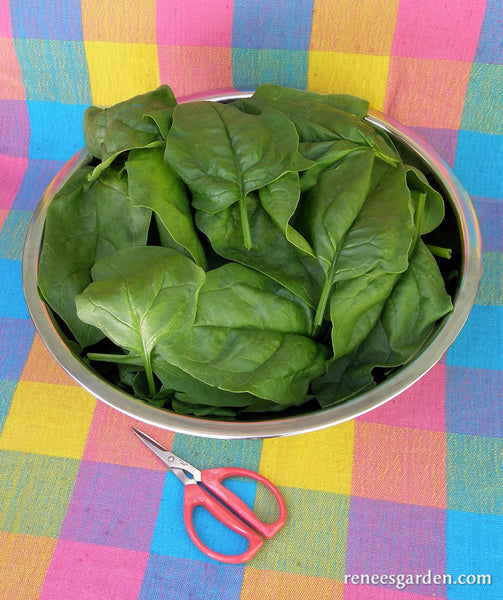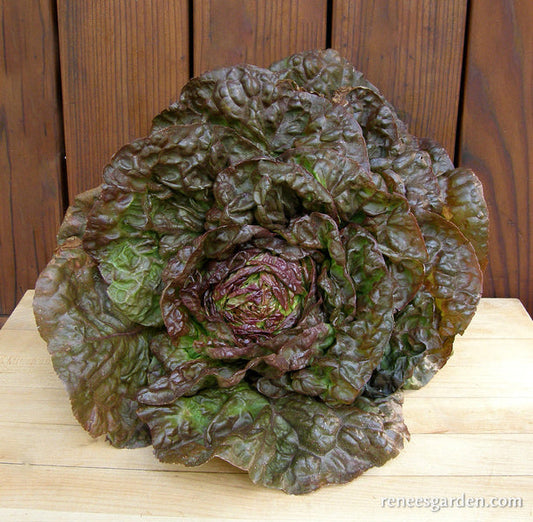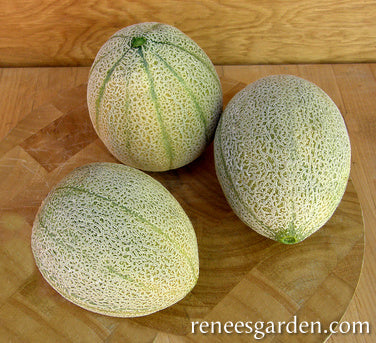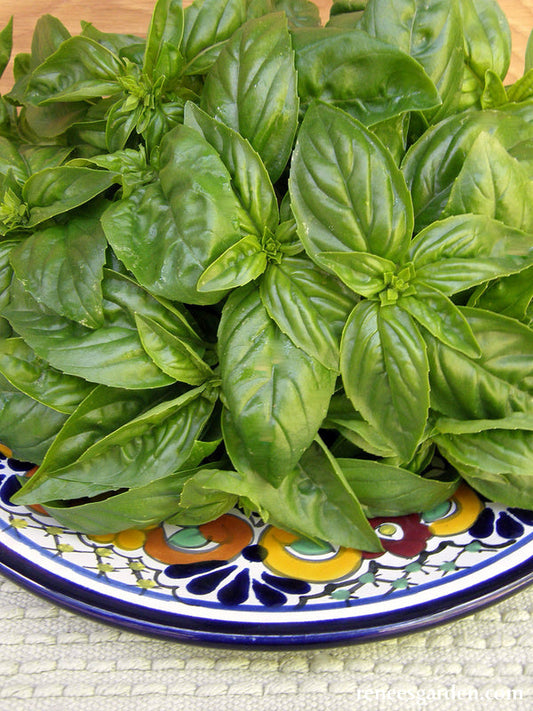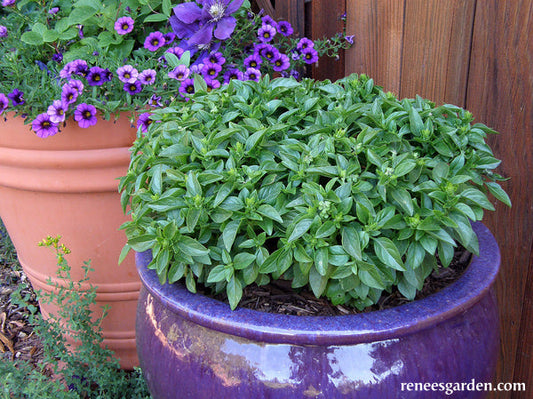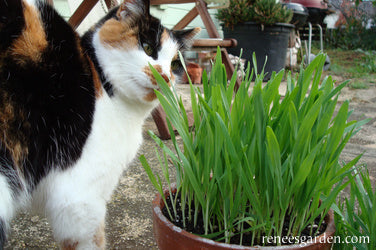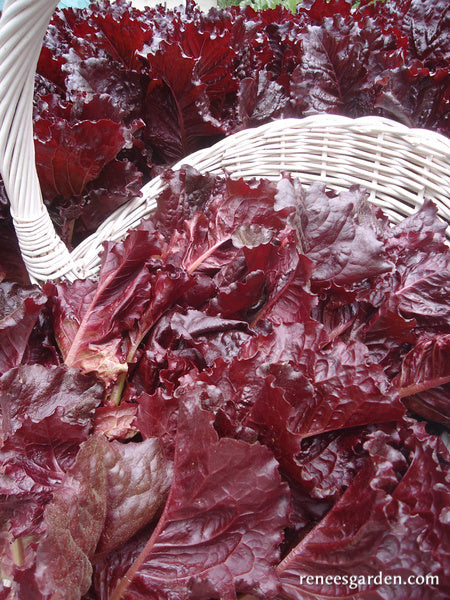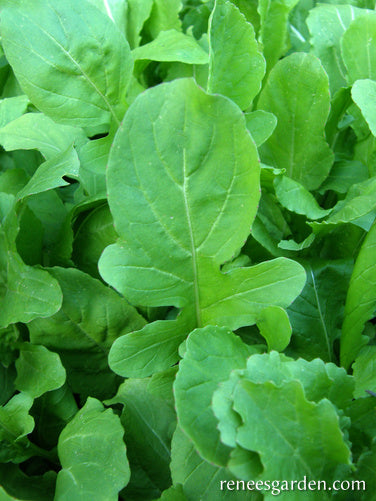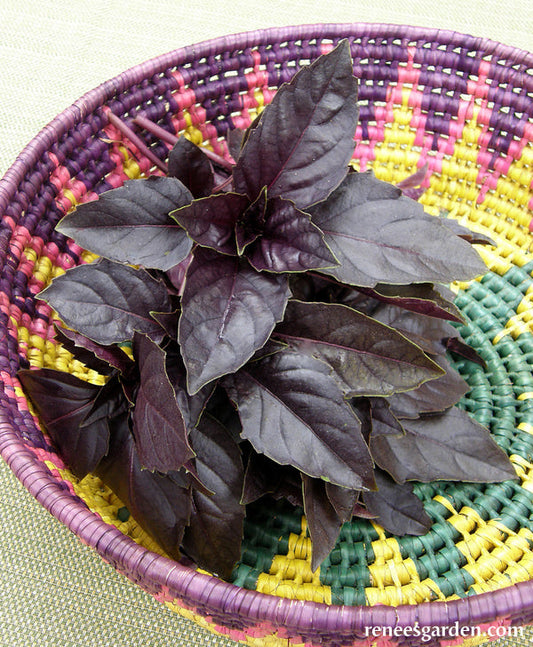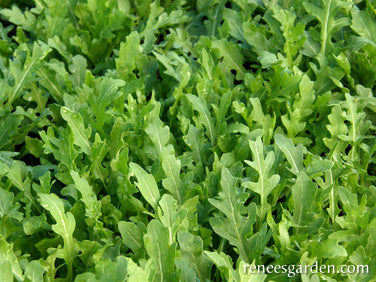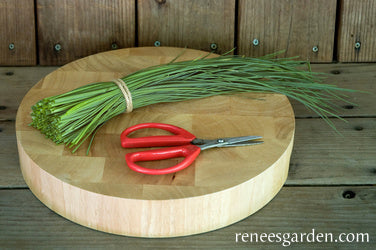Certified Organic
Certified Organic
-
Heirloom Culinary Sage
BEST TO START EARLY INDOORS
In early spring, sow seed 1 inch apart in a container of seed starting mix and cover 1/4 inch deep. Keep evenly moist as seedlings emerge and provide a strong light source until ready to plant outdoors. Transplant 12 to 18 inches apart when seedlings are about 2 or 3 inches tall after gradually acclimating plants to outdoor conditions.
TO PLANT OUTDOORS
Sow seeds 1 inch apart in well drained fertile soil in full sun in spring once weather is warm and settled. Cover 1/4 inch deep, firm soil over seeds and keep seedbed evenly moist. Germination takes 2 to 3 weeks. After seedlings are well established, thin or transplant 12 to 18 inches apart.
GROWING NOTES
Sage plants are resilient and drought tolerant once established. Cut leafy sprigs once plants are well filled out. After flowers stop blooming, cut them well down the branch to encourage more leaf growth. Add a small pinch of crushed fresh sage to vegetables, casseroles, pork, poultry stuffing and cheese dishes. Combine fresh sage with chopped parsley to mellow its pungency. To dry, hang leafy branches upside down in a cool airy place.Regular price $4.89Sale price $4.89Unit price / per -
Heirloom Parsley Italian Large Leaf
EASIEST TO START OUTDOORS
Start parsley in spring when weather is settled but still cool and/or in late summer in mild winter climates. Plant in full sun or half-day sun if climate is very hot. Sow seeds 1- 2 inches apart into a well-worked fertile seed bed. Cover 1/4 inch deep. Parsley germinates unevenly over several weeks; be patient and keep seed bed evenly moist. Using synthetic row covers to hold moisture during germination is helpful; remove when seedlings are well established.
TO PLANT INDOORS
In early spring, sow seeds 1 inch apart and 1/4 inch deep in a container of seed starting mix. Keep container moist but not soggy until seedlings emerge. Provide a good light source. Feed seedlings frequently until ready to transplant when several inches tall.
THIN OR TRANSPLANT
Space 3 to 4 inches apart when seedlings large enough to handle.
GROWING NOTES
Parsley needs rich moist soil and ample spacing for lush harvests. Thin early and keep well weeded and watered. Begin to harvest sparingly once plants have 8 to 10 leaves. Fertilize frequently with a high nitrogen source.Regular price $4.89Sale price $4.89Unit price / per -
Heirloom English Thyme
BEST TO PLANT INDOORS
Sow thyme in early spring in a container of seed starting mix. Cover seeds very lightly and keep evenly moist but not soggy until seedlings emerge in 14 to 21 days. Provide a good light source. Transplant when seedlings are about 2 inches tall after gradually acclimating to outdoor conditions.
TO START IN THE GARDEN
Plant thyme after soil has warmed up in spring in a finely textured seed bed with good drainage in full sun. Sow very thinly, cover seed lightly and be careful to keep the seed bed evenly moist and well weeded while seedlings are young.
THIN OR TRANSPLANT
Space clusters of 3 seedlings 8 to 10 inches apart when large enough to handle.
GROWING NOTES
Given a sunny location with good drainage, easy-growing thyme plants are reliable productive and long-lived garden perennials. Little lilac flowers bloom in midsummer; cut back foliage halfway when the blossoms fade to keep plants looking fresh. Cut leafy thyme sprigs as needed once plants are well established.Regular price $4.89Sale price $4.89Unit price / per -
Heirloom Sweet Parsley Triple Curled
BIENNIAL, GROWN AS ANNUAL
Spring/summer/fall harvest
Frost hardyTO PLANT DIRECTLY IN THE GARDEN
In spring when weather is settled but still cool, sow seeds 1 to 2 inches apart into well-worked fertile soil in full sun and cover 1/4 inch deep. If climate is very hot, plant in a spot with morning sun and afternoon shade. Parsley germinates unevenly over several weeks; be patient and keep moist.
TO START EARLY INDOORS
Sow parsley seeds in early spring in a container of seed starting mix. Cover 1/4 inch deep, and keep container moist but not soggy until seedlings emerge. Provide a good light source. Feed seedlings frequently until ready to transplant when about 2 inches tall after acclimating to outdoor conditions.
THIN OR TRANSPLANT
Space 4 to 6 inches apart when seedlings have several sets of leaves. Feed monthly for best results.
GROWING NOTES
Parsley needs rich moist soil and ample spacing for lush harvests. Thin early and keep well weeded and watered. Begin to harvest sparingly once plants have 8 to 10 leaves. Fertilize monthly with a high nitrogen source for best leafy growth.Regular price $4.89Sale price $4.89Unit price / per -
Baby Butternut Squash Climbing Honey Nut
BEST TO START OUTDOORS
Honey Nuts need full sun, rich fertile soil and warm temperatures. Wait to plant until nights are comfortably above 50°F (10°C) both day and night. Sow groups of 2 to 3 seeds 2 ft. apart and 1 in. deep in rows 4 ft. apart. Thin to 1 strong seedling per group to give vines room to ramble or climb. Or make slightly mounded hills 2 to 3 ft. across and 6 ft. apart and plant 4 to 5 seeds in each hill. When seedlings have several sets of leaves, thin to the strongest 3 seedlings per hill.
GROWING NOTES
Protect young seedlings from marauding birds by covering with plastic berry baskets at sowing time, removing before plants get crowded. To save space, and make picking easy, Honey Nut vines can easily be trained up fences, trellises or 4-6 foot tall teepees.
HARVEST AND USE
These delicious little squashes need to mature properly, so don’t harvest until vines have died back and squashes’ exterior rinds are fully colored up from dark green to orangey-tan and tough enough to resist piercing with a fingernail. Then cut squashes from vines, leaving a good stem handle. Let squashes cure in the sun for about 10 days, then store in a cool dry place and they’ll keep for months. In the kitchen, cut Honey Nuts in half then bake until tender. Flesh is meltingly sweet and delicious.Regular price $4.89Sale price $4.89Unit price / per -
Heirloom Sauce Tomato Italian San Marzano
STARTING SEEDLINGS
In early spring, start indoors about 6 to 8 weeks before outdoor night temperatures are reliably in the 50-55°F (10-13°C) range. Sow seeds 1/4 inch deep and 1 inch apart in a container of seed starting mix. Keep moist but not soggy, and very warm, 80°F (27°C). Provide a strong light source until seedlings are ready to plant outside.
When 2 inches tall, transplant into individual 4-inch pots, burying stems up to base of leaves. Maintain at 70-75°F (21-24°C). Feed with half-strength fertilizer every 2 weeks until ready to plant, then gradually acclimate seedlings to outdoor conditions. When nights reach 55°F (10°C), transplant 3 feet apart into rich soil in full sun.
GROWING NOTES
Prepare soil well with aged manure or compost. Plant several inches deeper than seedlings were growing in containers. Provide strong stakes or tall wire cages at planting time. Mulch to provide even moisture retention; don’t overwater once fruit begins to ripen.
HARVEST AND USE
These plump, sausage-shaped tomatoes are good fresh eating as well as traditional and perfect for making thick rich sauce. Big harvests of whole ripe fruits can be frozen in ziplock bags to make sauce later at your leisure.Regular price $4.89Sale price $4.89Unit price / per -
Snack Seed Sunflowers Heirloom Mammoth Greystripe
ANNUAL
Summer/fall bloom
Frost tenderEASIEST TO START DIRECTLY IN THE GARDEN
Plant in full sun in good garden soil when all danger of frost is past and temperatures have reached at least 50°F (10°C) both day and night. Poke seeds into well-worked soil 1 inch deep and 6 inches apart. Press soil firmly over seeds and keep moist as seedlings emerge.
THIN OR TRANSPLANT
When seedlings are about 3 inches tall, thin to 12 to 18 inches apart with 2 feet between rows to give growing plants room to establish strong roots and sturdy stalks that won’t blow over.
GROWING NOTES
Keep soil moist and well weeded and protect seedlings from birds at planting time with netting or plastic berry baskets, removing before plants get crowded. For large heads, space seedlings at least 12 inches apart so plants can grow to full size.
HARVEST AND USE
As sunflowers bloom, bees pollinate the florets in each head and seeds begin to mature. When center disk florets have dried up, cover the ripening seed heads loosely with paper bags if you don’t want birds to eat the seeds. When ripened kernels are plump and hard-shelled, cut entire heads, dry fully, then remove the seeds by hand. Store in closed containers to eat for snacks or feed to the birds over the winter.Regular price $4.89Sale price $4.89Unit price / per -
Heirloom Mesclun Lettuces Five Variety Blend
START SEEDS OUTDOORS
In early spring, sow seeds in finely worked soil in full sun. Shake seeds from the palm of your hand, broadcasting them about a half inch apart over the entire seedbed or in wide rows, and cover lightly and evenly with 1/4 inch of fine soil. Firm soil gently and water in with a fine spray. Keep seedbed evenly moist. Make small successive sowings until summer weather turns hot for a constant supply. Plant again in late summer for fall harvesting. Or, space seedlings 8 to 10 inches apart and let them mature to full size heads.
GROWING NOTES
Lettuce thrives in mild weather with consistent moisture. To extend the sowing season into hot weather, sow in light shade or erect a canopy of loosely woven shade cloth over the lettuce bed. Birds are often attracted to tender young seedlings so protect them if necessary.
HARVEST AND USE
To harvest by the “cut and come again” method, wait until plants are 4 or 5 inches tall. Cut as much as you need, using scissors to shear off a patch of leaves 1 to 2 inches above the soil level. Water well and fertilize lightly and plants will regrow for several more cuttings. Dress with extra virgin olive oil and a mild fruit or balsamic vinegar to enjoy the sweet flavors and juicy textures of these delicate young leaves at their best.
Regular price $4.89Sale price $4.89Unit price / per -
Heirloom Cutting Lettuce Flashy Trout Back
START SEEDS OUTDOORS
In cool early spring weather, start seeds in finely worked soil in full sun. Sow 1/4 inch deep and 2 inches apart in rows 6 to 8 inches apart and cover lightly. Tend carefully and keep evenly moist. Gradually thin out extra seedlings, leaving remaining plants standing 10 to 12 inches apart so lettuces have room to size up and fully mature into leafy butterhead rosettes. For a constant supply, make several sowings a few weeks apart until summer weather turns hot. Plant again in late summer for fall harvest.
GROWING NOTES
Lettuce thrives in cool conditions with consistent moisture. Weed, water and be sure to thin carefully to proper spacing so plants have room to mature. If birds are attracted to young seedlings, cover with floating row covers or netting. Make a shade structure in hotter climates to extend the growing season.
HARVEST AND USE
Savor young thinnings in your first spring salads. Then harvest plants by cutting mature heads when they feel firm and well-filled out. Be sure to thin properly and keep evenly moist for sweet tasting, full heads. Pull and discard or compost over-mature plants if they begin to elongate (“bolt”) in hot weather as leaves turn bitter at this stage.
Regular price $4.89Sale price $4.89Unit price / per -
Heirloom Romaine Lettuce Jericho
START SEEDS OUTDOORS
In cool early spring weather, start seeds in finely worked soil in full sun. Sow 1/4 inch deep and 2 inches apart in rows 6 to 8 inches apart and cover lightly. Tend carefully and keep evenly moist. Gradually thin out extra seedlings, leaving remaining plants standing 12 inches apart so lettuces have room to size up and fully mature into big butterhead rosettes. For a constant supply, make several sowings a few weeks apart until summer weather turns hot. Plant again in late summer for fall harvest.
GROWING NOTES
Lettuce thrives in cool conditions with consistent moisture. Weed, water and be sure to thin carefully to proper spacing for best quality heavy heads. If birds are attracted to young seedlings, cover with floating row covers or netting. Make a shade structure in hotter climates to extend the growing season.
HARVEST AND USE
Savor young thinnings in your first spring salads. Then harvest plants by cutting mature heads when they feel firm and well-filled out. Be sure to thin properly and keep evenly moist for sweet tasting, full heads. Pull and discard or compost over-mature plants if they begin to elongate (“bolt”) in hot weather as leaves turn bitter at this stage.
Regular price $4.89Sale price $4.89Unit price / per -
Heirloom Container Lettuce Jade Gem
START SEEDS OUTDOORS
In cool spring weather, start seeds in full sun. Sow seeds ¼ inch deep and 1 inch apart in fertile, well-drained soil. Keep evenly moist but not soggy. As seedlings begin to grow, it’s critical to thin out young plants to a final spacing of 8 inches apart so they have room to mature to large, leafy rosettes (extra seedlings will transplant easily to grow elsewhere). Container Growing: Plan on 5 to 7 full heads in a 16 to 18 inch pot or a 9 x 12 inch windowbox; 3 full heads in an 8 inch pot.
GROWING NOTES
Lettuce thrives in cool conditions. Carefully thin and keep evenly moist for sweet tasting, full heads. For a constant supply, make several sowings a few weeks apart until summer heat comes on. In hot weather, give lettuce some afternoon shade and check water daily. Feed with liquid fertilizer every 2 weeks. Sow more seed in late summer for delicious fall harvests.
HARVEST AND USE
Use these little beauties in containers or as an edible garden accent or border. Or transplant seedlings around edges of a big pot holding a young tomato or pepper plant, then harvest when the bigger plants need the space. Savor young thinnings in your first spring salads. Harvest mature little heads when they are solid and well-filled out. Pull over-mature plants if they begin to elongate (“bolt”) in hot weather.
Regular price $4.89Sale price $4.89Unit price / per -
Heirloom Butterhead Lettuce Kagraner Sommer
START SEEDS OUTDOORS
In cool early spring weather, start seeds in finely worked soil in full sun. Sow 1/4 inch deep and 2 inches apart in rows 6 to 8 inches apart and cover lightly. Tend carefully and keep evenly moist. Gradually thin out extra seedlings, leaving remaining plants standing 12 inches apart so lettuces have room to size up and fully mature into big butterhead rosettes. For a constant supply, make several sowings a few weeks apart until summer weather turns hot. Plant again in late summer for fall harvest.
GROWING NOTES
Lettuce thrives in cool conditions with consistent moisture. Weed, water and be sure to thin carefully to proper spacing for best quality heavy heads. If birds are attracted to young seedlings, cover with floating row covers or netting. Make a shade structure in hotter climates to extend the growing season.
HARVEST AND USE
Savor young thinnings in your first spring salads. Then harvest plants by cutting mature heads when they feel firm and well-filled out. Be sure to thin properly and keep evenly moist for sweet tasting, full heads. Pull and discard or compost over-mature plants if they begin to elongate (“bolt”) in hot weather as leaves turn bitter at this stage.
Regular price $4.89Sale price $4.89Unit price / per -
Longstanding Spinach Gangbusters
START SEEDS OUTDOORS
In early spring when danger of hard frost is over, sow seeds in well-worked fertile soil in full sun. Sow seeds 1 inch apart and 1/2 inch deep in rows 10 inches apart, or broadcast thinly for bed planting. Be sure to firm soil well over seeds to ensure good germination. If first sowing germinates unevenly, plant more seeds as they will catch up fast.
GROWING NOTES
Spinach is most productive grown in cool spring conditions and sown again in late summer for a fall crop. After seedlings reach 2 to 3 inches tall, thin out every other plant (and enjoy in early salads) and keep thinning in this fashion until plants are spaced 5 or 6 inches apart. Keep the shallow-rooted plants well weeded and watered. Spinach is a heavy feeder so fertilize several times with fish emulsion solution for best harvests.
HARVEST AND USE
There are two methods for harvesting spinach: either cut the entire plant 1 inch or so above the base once plants are 4 or 5 inches tall, or wait until plants are well established and harvest just the outer leaves, leaving at least 4 center leaves so plant will continue to grow. Water and fertilize after cutting and plants will provide 2 or 3 pickings before weather gets too warm and spinach begins to go to seed.Regular price $4.89Sale price $4.89Unit price / per -
Summer Bibb Lettuce Patty's Choice
START SEEDS OUTDOORS
In cool early spring weather, start seeds in finely worked soil in full sun. Sow 1/4 inch deep and 2 inches apart in rows 6 to 8 inches apart and cover lightly. Tend carefully and keep evenly moist. Gradually thin out extra seedlings, leaving remaining plants standing 12 inches apart so lettuces have room to size up and fully mature into big butterhead rosettes. For a constant supply, make several sowings a few weeks apart until summer weather turns hot. Plant again in late summer for fall harvest.
GROWING NOTES
Lettuce thrives in cool conditions with consistent moisture. Weed, water and be sure to thin carefully to proper spacing for best quality heavy heads. If birds are attracted to young seedlings, cover with floating row covers or netting. Make a shade structure in hotter climates to extend the growing season.
HARVEST AND USE
Savor young thinnings in your first spring salads. Then harvest plants by cutting mature heads when they feel firm and well-filled out. Be sure to thin properly and keep evenly moist for sweet tasting, full heads. Pull and discard or compost over-mature plants if they begin to elongate (“bolt”) in hot weather as leaves turn bitter at this stage.
Regular price $4.89Sale price $4.89Unit price / per -
Heirloom Tuscan Melon Melone Retato Degli Ortolani
STARTING SEEDLINGS OUTDOORS
Melons need full sun, rich soil and warm temperatures. Plant only when weather is warm and settled and temperatures stay above 50° (10°C). In rows 4 feet apart, sow groups of 2 to 3 seeds every 2 feet. After germination, thin to the strongest seedling per group, so you end up with one plant every 2 feet. Or make slightly mounded hills, 2 feet in diameter and 5 feet apart, sowing 5 or 6 seeds in each hill. Thin to 3 strongest plants.
TO START EARLY INDOORS
Several weeks before last frost date, sow seeds in individual pots of seed starting mix. Keep warm and moist, and provide a strong light source until weather warms enough to transplant outdoors.
GROWING NOTES
Amend soil well with aged manure or compost. Where summers are short or cool, lay down black plastic to retain heat, and plant into holes made in plastic. Where insects are a problem, cover seedlings with floating row covers to exclude them, removing when plants blossom. Keep young vines well watered and fed, tapering off as fruits ripen up for best sweet flavor.
HARVEST AND USE
Pick melons when they are fully colored, heavy and fragrant and “slip” or pull easily from the vines. These deeply lobed melons with sweet aromatic flesh are delicious freshly picked and sliced, added to fruit salads or wrapped with prosciutto as a traditional Italian appetizer.
Regular price $4.89Sale price $4.89Unit price / per -
Heirloom Basil Italian Genovese
ANNUAL
Summer/fall harvest
Heat-loving, frost tenderTO PLANT DIRECTLY INTO THE GARDEN
When late spring weather has thoroughly warmed up, sow seeds 1 inch apart in well worked fertile soil in full sun. Cover 1/4 inch deep, firm soil and keep seedbed moist. Germination takes 1 to 2 weeks. After seedlings are well established, thin or transplant 8 inches apart to allow plants room to mature.
TO START EARLY INDOORS
Sow seeds 1 inch apart in a container of seed starting mix, 4 to 6 weeks before last expected frost. Keep warm and evenly moist, and provide a good light source. When seedlings are large enough to handle and weather is warm, acclimate gradually to outdoor conditions before planting in the garden 8 inches apart.
GROWING NOTES
Remember — it is critical to plant basil in the garden only after late spring day and nighttime temperatures stay above 50°F (10°C). Pinch off growing tips when plants are 6 to 8 inches tall to encourage branching. Harvest sprays of leaves by cutting stems just above two new sprouting lateral branches to get lush regrowth. Keep flower buds pinched off to extend harvesting and feed regularly to promote new growth.Regular price $4.89Sale price $4.89Unit price / per -
Heirloom Container Basil Spicy Globe
TO PLANT DIRECTLY IN THE GARDEN
Spicy Globe seeds are coated with a natural clay material to make them easy to sow. When late spring weather has warmed up to the 50°F (10°C) range both day and night, sow seeds 1 inch apart in well worked, fertile soil or containers of fresh potting mix in full sun. Cover 1/4 inch deep, firm soil and keep the seed bed evenly moist. After seedlings are large enough to handle, thin or transplant 6 inches apart. For containers, transplant one seedling per 6 inch pot or 3 seedlings into a 12 inch pot.TO START EARLY INDOORS
Sow 1 inch apart and 1/4 inch deep in a container of seed starting mix, 4 to 6 weeks before last expected frost. Keep warm and evenly moist and provide a good light source. When seedlings are large enough to handle and weather is above 50°F (10°C) both day and night, transplant outdoors. For containers, transplant one seedling per 6 inch pot or 3 seedlings into a 12 inch pot. Or plant along a garden border for a fragrant edging.GROWING NOTES
Remember to plant basil outdoors only after nighttime temperatures stay above 50°F (10°C). In hot, dry weather, check and water plants in containers daily. Feed every 2 weeks to promote growth.Regular price $4.89Sale price $4.89Unit price / per -
Kitty Queen's Four Grass Mix
ANNUAL CEREAL GRASSES
Oat, rye, wheat, barley.
Organically grown.FOR BEST RESULTS
Fill a 6 inch diameter or larger, pot with moistened planting mix. Sprinkle seeds 1/4 inch apart over the surface, cover 1/2 inch deep with mix, and water gently. Keep pot moist but not soggy, and be sure to provide a good light source. The pot of grasses can be kept indoors for pets to graze on at their leisure. Fertilize every 2 weeks using a non-chemical fertilizer, such as fish emulsion.
DINING IDEAS
Most cats will recognize the grass as a treat right away. To encourage finicky eaters, place the pot beside the kitty’s food and spritz it with water. This usually does the trick.
GROWING NOTES
Our ample packet provides enough seed for 3 to 4 sowings. The grasses are ready for pets to nibble when the blades are at least a few inches tall, normally in about 10-14 days after sowing. If grasses get too tall and fall over, “mow” them down to 2 inches with a pair of scissors.
For a constant supply, try sowing one pot, then another pot a week later. Give your pet access to only one pot of grass at a time, and switch pots each week. When grass does not re-grow vigorously after cutting down and fertilizing, discard and start again with new seed and soil mix.
DINING IDEAS
Most cats will recognize the grass as a treat right away. To encourage finicky eaters, place the pot beside the kitty's food and spritz it with water. This usually does the trick and cats who newly discover this treat delight in it!Regular price $4.89Sale price $4.89Unit price / per -
French Red Leaf Lettuce Redina
START SEEDS OUTDOORS
In cool early spring weather, start seeds in finely worked soil in full sun. Sow 1/4 inch deep and 2 inches apart in rows 6 to 8 inches apart and cover lightly. Tend carefully and keep evenly moist. Gradually thin out extra seedlings, leaving remaining plants standing 12 inches apart so lettuces have room to size up and fully mature into big butterhead rosettes. For a constant supply, make several sowings a few weeks apart until summer weather turns hot. Plant again in late summer for fall harvest.
GROWING NOTES
Lettuce thrives in cool conditions with consistent moisture. Weed, water and be sure to thin carefully to proper spacing for best quality heavy heads. If birds are attracted to young seedlings, cover with floating row covers or netting. Make a shade structure in hotter climates to extend the growing season.
HARVEST AND USE
Savor young thinnings in your first spring salads. Then harvest outside leaves as needed, or let plants mature and cut well-filled out heads. Be sure to thin properly and keep evenly moist for sweet tasting, full heads. Pull and discard or compost over-mature plants if they begin to elongate (“bolt”) in hot weather as leaves turn bitter at this stage.
Regular price $4.89Sale price $4.89Unit price / per -
Arugula True Italian
EASIEST TO START OUTDOORS
In early spring, sow seeds directly into well-worked garden soil 1 to 2 inches apart in rows 10 inches apart in full sun. Cover 1/4 inch deep and firm soil over seeds. Keep seed bed evenly moist until seedlings emerge in 7 to 14 days. Make new sowings every 2 weeks until early summer for a constant supply of fresh non-bitter leaves. Young leaves are ready to begin harvesting in 3 to 4 weeks. In hot summer areas, wait to sow again in late summer for fall use, as summer heat makes leaves very pungent.THIN OR TRANSPLANT
Arugula grows so quickly we recommend sowing in place rather than transplanting. Thin seedlings 2 to 3 inches apart when plants are large enough to handle.GROWING NOTES
Begin harvesting by thinning little seedlings to use in salads when they are several inches tall, leaving remaining seedlings to mature 2 to 3 inches apart. Either pick individual leaves when they are 3 to 4 inches long, or snip leaves about 1 inch above the crown and let plants regrow for more harvests.Regular price $4.89Sale price $4.89Unit price / per -
Heirloom Basil Purple Opal
TO PLANT DIRECTLY INTO THE GARDEN
When late spring weather has thoroughly warmed up, sow seeds 1 inch apart in well worked fertile soil in full sun. Cover 1/4 inch deep, firm soil and keep seedbed moist. Germination takes 1 to 2 weeks. After seedlings are well established, thin or transplant 8 inches apart to allow plants room to mature.
TO START EARLY INDOORS
Sow seeds 1 inch apart in a container of seed starting mix, 4 to 6 weeks before last expected frost. Keep warm and evenly moist, and provide a good light source. When seedlings are large enough to handle and weather is warm, acclimate gradually to outdoor conditions before planting in the garden 8 inches apart.
GROWING NOTES
Remember — it is critical to plant basil in the garden only after late spring day and nighttime temperatures stay above 50°F (10°C). Pinch off growing tips when plants are 6 to 8 inches tall to encourage branching. Harvest sprays of leaves by cutting stems just above two new sprouting lateral branches to get lush regrowth. Keep flower buds pinched off to extend harvesting and feed regularly to promote new growth.Regular price $4.89Sale price $4.89Unit price / per -
Heirloom Arugula Rustic Style
EASIEST TO START OUTDOORS
Plant seeds in early spring or in late summer for a fall crop. Sow seed as thinly as possible, cover 1/4 inch deep and firm soil gently over seeds. Keep seed-bed evenly moist until seedlings emerge in 1 to 2 weeks.
THIN OR TRANSPLANT
Thin seedlings 5 to 6 inches apart when plants are large enough to handle.
GROWING NOTES
Long lasting rustic arugula stays leafy so you can harvest all season long from the same plants. Harvest individual leaves at 4 to 5 inches long, or cut bunches of young tender leaves as needed. Keep the little yellow blossoms pruned back for best leaf production or use for tangy edible flowers. Rustic will winter over in mild climates but make a fresh sowing each spring for best quality.
Regular price $4.89Sale price $4.89Unit price / per -
Heirloom Cilantro
EASIEST TO START OUTDOORS
In early spring, sow Cilantro seed directly into well-drained fertile soil 1 to 2 inches apart in rows 8 inches apart in full sun. Cover 1/2 inch deep and firm soil over seeds. Keep seed bed evenly moist as seedlings emerge over 10 to 20 days. Make new sowings every few weeks until mid summer for continuous harvests of fresh leaves.
THIN OR TRANSPLANT
Cilantro doesn’t transplant well; we advise direct garden sowing. Thin seedlings 3 to 4 inches apart before plants get crowded.
GROWING NOTES
Cilantro plants flower, then set seed quickly as plants mature. Lushest, leafy growth takes place in cooler weather; plant early and throughout cool spring weather and sow again in fall, particularly in mild winter areas. To have a constant supply of fresh leaves, sow every 2 to 3 weeks through early summer. Keep cilantro at its leafy stage longer by keeping plants well watered and being careful to thin seedlings early. Let some of the lacy flowers form to attract beneficial insects and pollinating bees. The fragrant round seeds are called coriander, an aromatic spice used in baking.
Regular price $4.89Sale price $4.89Unit price / per -
Heirloom Culinary Chives
PERENNIAL
Spring/summer/fall harvest
Frost hardyTO PLANT OUTDOORS
In cool spring weather, sow clusters of 7 to 10 seeds about 8 to 10 inches apart in well-worked, fertile soil in sun or part shade. Cover 1/4 inch deep and press soil firmly over seeds. Keep evenly moist as seeds germinate slowly over several weeks. Emerging clusters of seedlings have very slender grass-like leaves that mature into mounds.
TO START EARLY INDOORS
In early spring, sow 7 to 10 seeds in individual containers of starting mix and cover 1/4 inch deep. Keep evenly moist as seedlings slowly emerge and provide a good light source until ready to plant outdoors. Transplant clusters of seedlings when 2 to 3 inches tall after gradually acclimating plants to outdoor conditions.
THIN OR TRANSPLANT
Space clusters of 7 to 10 seedlings 8 to 10 inches apart.
GROWING NOTES
Chives bear lilac-pink clover-like flowers in late spring and summer. After bloom finishes, cut entire plant back to 2 inches to encourage regrowth of tender new leaves. Given plenty of moisture and a location out of fierce sun, chives are hardy, self-sufficient plants. lilac-pink clover-like flowers in late spring and summer. After bloom finishes, cut entire plant back to 2 inches to encourage regrowth of tender new leaves. Given plenty of moisture and a location out of fierce sun, chives are hardy, self sufficient plants.Regular price $4.89Sale price $4.89Unit price / per

